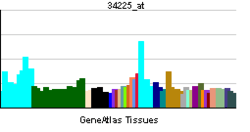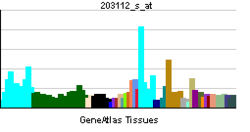WHSC2
| Negative elongation factor complex member A | |||||||||||||
|---|---|---|---|---|---|---|---|---|---|---|---|---|---|
| Identifiers | |||||||||||||
| Symbols | NELFA ; NELF-A; WHSC2 | ||||||||||||
| External IDs | OMIM: 606026 MGI: 1346098 HomoloGene: 68478 GeneCards: NELFA Gene | ||||||||||||
| |||||||||||||
| RNA expression pattern | |||||||||||||
 | |||||||||||||
 | |||||||||||||
| More reference expression data | |||||||||||||
| Orthologs | |||||||||||||
| Species | Human | Mouse | |||||||||||
| Entrez | 7469 | 24116 | |||||||||||
| Ensembl | ENSG00000185049 | ENSMUSG00000029111 | |||||||||||
| UniProt | Q9H3P2 | Q8BG30 | |||||||||||
| RefSeq (mRNA) | NM_005663 | NM_011914 | |||||||||||
| RefSeq (protein) | NP_005654 | NP_036044 | |||||||||||
| Location (UCSC) | Chr 4: 1.98 – 2.04 Mb | Chr 5: 33.9 – 33.94 Mb | |||||||||||
| PubMed search | |||||||||||||
Negative elongation factor A is a protein that in humans is encoded by the WHSC2 gene.[1][2]
This gene is expressed ubiquitously with higher levels in fetal than in adult tissues. It encodes a protein sharing 93% sequence identity with the mouse protein. Wolf-Hirschhorn syndrome (WHS) is a malformation syndrome associated with a hemizygous deletion of the distal short arm of chromosome 4. This gene is mapped to the 165 kb WHS critical region, and may play a role in the phenotype of the WHS or Pitt-Rogers-Danks syndrome. The encoded protein is found to be capable of reacting with HLA-A2-restricted and tumor-specific cytotoxic T lymphocytes, suggesting a target for use in specific immunotherapy for a large number of cancer patients. This protein has also been shown to be a member of the NELF (negative elongation factor) protein complex that participates in the regulation of RNA polymerase II transcription elongation.[2] WHSC2 encodes the NELF-A subunit of the NELF complex.[3]
Interactions
WHSC2 has been shown to interact with RDBP.[4]
References
- ↑ Wright TJ, Costa JL, Naranjo C, Francis-West P, Altherr MR (Sep 1999). "Comparative analysis of a novel gene from the Wolf-Hirschhorn/Pitt-Rogers-Danks syndrome critical region". Genomics 59 (2): 203–12. doi:10.1006/geno.1999.5871. PMID 10409432.
- ↑ 2.0 2.1 "Entrez Gene: WHSC2 Wolf-Hirschhorn syndrome candidate 2".
- ↑ Narita, Takashi; Yamaguchi, Yuki ; Yano, Keiichi; Sugimoto, Seiji; Chanarat, Sittinan; Wada, Tadashi; Kim, Dong-ki; Hasegawa, Jun; Omori, Masashi; Inukai, Naoto; Endoh, Masaki; Yamada, Tomoko; Handa, Hiroshi (2003). "Human Transcription Elongation Factor NELF: Identification of Novel Subunits and Reconstitution of the Functionally Active Complex". Molecular and Cellular Biology 23 (6): 1863–1873. doi:10.1128/MCB.23.6.1863-1873.2003. PMC 149481. PMID 12612062.
- ↑ Narita, Takashi; Yamaguchi Yuki, Yano Keiichi, Sugimoto Seiji, Chanarat Sittinan, Wada Tadashi, Kim Dong-ki, Hasegawa Jun, Omori Masashi, Inukai Naoto, Endoh Masaki, Yamada Tomoko, Handa Hiroshi (Mar 2003). "Human Transcription Elongation Factor NELF: Identification of Novel Subunits and Reconstitution of the Functionally Active Complex". Mol. Cell. Biol. (United States) 23 (6): 1863–73. doi:10.1128/MCB.23.6.1863-1873.2003. ISSN 0270-7306. PMC 149481. PMID 12612062.
Further reading
- Gutmajster E, Rokicka A (2003). "[Genetic determination of Wolf-Hirschhorn syndrome ]". Wiad. Lek. 55 (11–12): 706–10. PMID 12715353.
- Stevens M, De Clercq E, Balzarini J (2007). "The regulation of HIV-1 transcription: molecular targets for chemotherapeutic intervention". Med Res Rev 26 (5): 595–625. doi:10.1002/med.20081. PMID 16838299.
- Maruyama K, Sugano S (1994). "Oligo-capping: a simple method to replace the cap structure of eukaryotic mRNAs with oligoribonucleotides". Gene 138 (1–2): 171–4. doi:10.1016/0378-1119(94)90802-8. PMID 8125298.
- Andersson B; Wentland MA; Ricafrente JY et al. (1996). "A "double adaptor" method for improved shotgun library construction". Anal. Biochem. 236 (1): 107–13. doi:10.1006/abio.1996.0138. PMID 8619474.
- Wright TJ; Ricke DO; Denison K et al. (1997). "A transcript map of the newly defined 165 kb Wolf-Hirschhorn syndrome critical region". Hum. Mol. Genet. 6 (2): 317–24. doi:10.1093/hmg/6.2.317. PMID 9063753.
- Yu W; Andersson B; Worley KC et al. (1997). "Large-Scale Concatenation cDNA Sequencing". Genome Res. 7 (4): 353–8. doi:10.1101/gr.7.4.353. PMC 139146. PMID 9110174.
- Suzuki Y; Yoshitomo-Nakagawa K; Maruyama K et al. (1997). "Construction and characterization of a full length-enriched and a 5'-end-enriched cDNA library". Gene 200 (1–2): 149–56. doi:10.1016/S0378-1119(97)00411-3. PMID 9373149.
- Yamaguchi Y; Takagi T; Wada T et al. (1999). "NELF, a multisubunit complex containing RD, cooperates with DSIF to repress RNA polymerase II elongation". Cell 97 (1): 41–51. doi:10.1016/S0092-8674(00)80713-8. PMID 10199401.
- Ping YH, Rana TM (2001). "DSIF and NELF interact with RNA polymerase II elongation complex and HIV-1 Tat stimulates P-TEFb-mediated phosphorylation of RNA polymerase II and DSIF during transcription elongation". J. Biol. Chem. 276 (16): 12951–8. doi:10.1074/jbc.M006130200. PMID 11112772.
- Mariotti M, Manganini M, Maier JA (2001). "Modulation of WHSC2 expression in human endothelial cells". FEBS Lett. 487 (2): 166–70. doi:10.1016/S0014-5793(00)02335-8. PMID 11150502.
- Ito M; Shichijo S; Tsuda N et al. (2001). "Molecular basis of T cell-mediated recognition of pancreatic cancer cells". Cancer Res. 61 (5): 2038–46. PMID 11280764.
- Yamaguchi Y; Filipovska J; Yano K et al. (2001). "Stimulation of RNA polymerase II elongation by hepatitis delta antigen". Science 293 (5527): 124–7. doi:10.1126/science.1057925. PMID 11387440.
- Yamaguchi Y; Inukai N; Narita T et al. (2002). "Evidence that Negative Elongation Factor Represses Transcription Elongation through Binding to a DRB Sensitivity-Inducing Factor/RNA Polymerase II Complex and RNA". Mol. Cell. Biol. 22 (9): 2918–27. doi:10.1128/MCB.22.9.2918-2927.2002. PMC 133766. PMID 11940650.
- Strausberg RL; Feingold EA; Grouse LH et al. (2003). "Generation and initial analysis of more than 15,000 full-length human and mouse cDNA sequences". Proc. Natl. Acad. Sci. U.S.A. 99 (26): 16899–903. doi:10.1073/pnas.242603899. PMC 139241. PMID 12477932.
- Zollino M; Lecce R; Fischetto R et al. (2003). "Mapping the Wolf-Hirschhorn Syndrome Phenotype Outside the Currently Accepted WHS Critical Region and Defining a New Critical Region, WHSCR-2". Am. J. Hum. Genet. 72 (3): 590–7. doi:10.1086/367925. PMC 1180235. PMID 12563561.
- Narita T; Yamaguchi Y; Yano K et al. (2003). "Human Transcription Elongation Factor NELF: Identification of Novel Subunits and Reconstitution of the Functionally Active Complex". Mol. Cell. Biol. 23 (6): 1863–73. doi:10.1128/MCB.23.6.1863-1873.2003. PMC 149481. PMID 12612062.
- Ota T; Suzuki Y; Nishikawa T et al. (2004). "Complete sequencing and characterization of 21,243 full-length human cDNAs". Nat. Genet. 36 (1): 40–5. doi:10.1038/ng1285. PMID 14702039.
- Beausoleil SA; Jedrychowski M; Schwartz D et al. (2004). "Large-scale characterization of HeLa cell nuclear phosphoproteins". Proc. Natl. Acad. Sci. U.S.A. 101 (33): 12130–5. doi:10.1073/pnas.0404720101. PMC 514446. PMID 15302935.